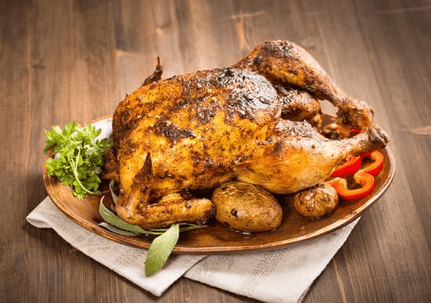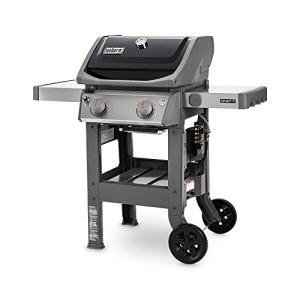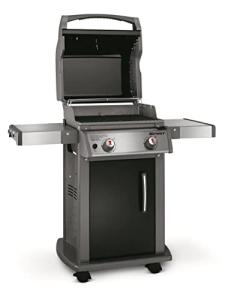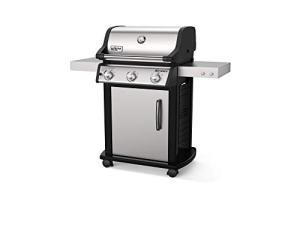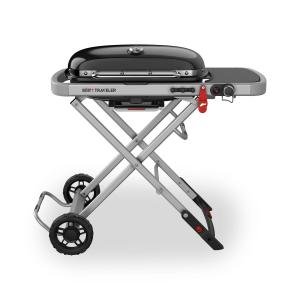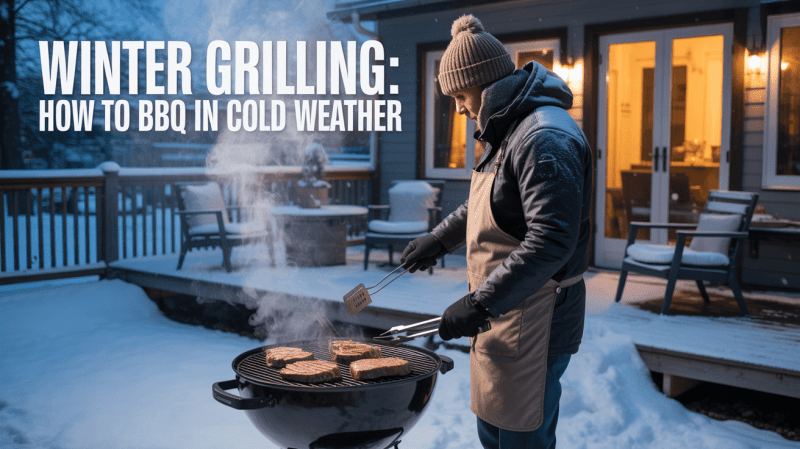Grilling a whole chicken might seem hard, but I'm here to help. I'll show you how to get a perfectly grilled whole chicken every time. The smell of grilled chicken in summer is amazing. It brings everyone together.
This guide will teach you to grill a whole chicken that's tender, juicy, and full of flavor. I've learned these tips from my outdoor cooking adventures. So, get ready to impress your guests with your grilling skills!
Key Takeaways
- Whole chickens typically weigh between 3 to 4 lbs.
- Dry brining should be done 12 to 24 hours prior for enhanced flavor.
- Cooking time is approximately 1 to 1.5 hours over indirect heat.
- Use a meat thermometer to ensure the internal temperature reaches 165°F (75°C).
- Let the chicken rest for 10 minutes before carving to maintain juiciness.
- Spatchcocking can reduce cooking time to about 45 minutes.
Introduction to Grilling Whole Chicken
Grilling whole chicken is a joy for many outdoor cooking fans. The mix of high heat and smoke gives a flavor that indoor cooking can't match. The smell of the chicken grilling is amazing, and the sight of crispy skin is a treat.
Preparing and grilling a whole chicken is more than just cooking. It's about enjoying the outdoors and sharing great food with loved ones.
For grilling a whole chicken, you need the right tools and techniques. A grill that gets hot, around 450°F, is best for perfect chicken. A meat thermometer helps ensure the chicken is safe and juicy, with an internal temperature of 165°F.
Grilling techniques, like indirect heat or spatchcocking, can make your chicken even better. In this guide, I'll walk you through grilling a whole chicken. We'll cover everything from the right equipment to the best grilling methods. You'll learn how to make that delicious grilled whole chicken everyone craves.
Benefits of Grilling a Whole Chicken
Grilling a whole chicken is great for outdoor gatherings. It's perfect for serving a big group because a whole chicken weighs 3.5 to 4.5 pounds. This makes it ideal for meals where everyone can share tasty bites.
Grilling whole chicken gives a unique taste experience. The smoky flavor and charring make the chicken taste amazing. This method also helps remove excess fat, making the meat leaner. Plus, it cooks faster than baking, taking only 35 to 40 minutes.
Marinades add flavor and keep the chicken moist. Brining the chicken for 6 to 48 hours makes it juicy. And, cooking it to 165°F ensures it's safe to eat.
Grilling is also fun and social. It brings people together while cooking, making the mealtime better. Adding grilling to your outdoor activities adds flavor and fun to your gatherings.
How to Grill a Whole Chicken
Grilling a whole chicken is a fun challenge in the kitchen. To get a delicious, evenly cooked meal, you need to prepare well. Here, I'll share the best ways to grill a whole chicken for a tasty and juicy dish.
Choosing the Right Chicken
Choose a whole chicken that weighs between 3 and 4 pounds. This size is perfect for grilling and feeds a family well. Make sure the chicken is fresh and, if you can, choose one that's antibiotic-free. The quality of the meat greatly affects the taste and texture, so this choice is key.
Preparing Your Grill for Indirect Heat
Setting up your grill for indirect heat is important when grilling a whole chicken. This method stops flare-ups and cooks the chicken evenly. For gas grills, turn on only one side of the burners. Keep the other side off. Use a drip pan to catch juices below the chicken.
For charcoal grills, arrange coals on one side. This creates a cooler zone on the other side for indirect cooking. This tutorial stresses the need for these setups for great results. Also, keep the grill temperature between 350°F and 375°F for the best cooking.
Preparing the Chicken for Grilling
Getting your chicken ready for the grill is key. It makes a big difference in taste and texture. Start by cleaning the chicken well. This means more than just rinsing; it's about removing unwanted parts.
Take out the giblets and trim off excess fat. This improves both looks and taste.
Cleaning and Trimming the Chicken
For cleaning, use cold water and paper towels. Dry the chicken well after rinsing. This helps the seasoning stick better later.
Remove any visible fat and skin. This makes the chicken look better and prevents flare-ups from fat drips. A clean chicken is ready for the next step.
Dry Brining for Flavor and Moisture
Dry brining makes the chicken juicy and flavorful. Just sprinkle kosher salt all over and refrigerate for at least an hour. Or, let it sit for up to two days for even more flavor.
The salt helps keep the meat moist. This makes every grilled piece juicy. I've seen how much better my grilled chicken tastes with this method. Everyone loves it!
Best Marinades and Seasoning Ideas
Finding the right marinade or seasoning can make grilled chicken taste amazing. You can choose simple flavors or bold ones. I'll share some top ideas, like a kosher salt rub, a zesty Mediterranean marinade, and spice blends. Each one will make your grilling better and your meal more enjoyable.
Simple Kosher Salt Seasoning
A simple kosher salt seasoning is great for those who like less fuss. Start with a 4-pound whole chicken, cleaned and dried. Rub it with kosher salt to bring out the chicken's natural taste. Use 1-2 teaspoons of kosher salt per pound and let it sit for 30 minutes before grilling.
Flavorful Mediterranean Marinade
For something more exciting, try a Mediterranean marinade. Mix 1 tablespoon of Dijon mustard, 1 tablespoon of extra virgin olive oil, and 1 lemon's juice. This adds flavor and keeps the chicken moist. Marinate for 4 to 6 hours, or up to 24 hours for the best taste. It serves 4 to 6 people, perfect for parties.
Spice Blends for Unique Flavors
For kitchen explorers, try different spice blends. Mix 1 teaspoon garlic powder, 1 teaspoon onion powder, 1/2 teaspoon chili powder, 1/2 teaspoon paprika, and 1/4 teaspoon cayenne. This mix balances heat and savory flavors. With these ideas, your grilled chicken will be a hit with everyone.
https://youtube.com/watch?v=7u0k6D83IJ4
Grilling Techniques for Whole Chicken
Grilling a whole chicken requires mastering certain techniques. These methods help improve flavor, ensure even cooking, and manage temperature well. Learning these techniques can greatly improve your grilling skills.
Indirect Grilling vs. Direct Grilling
Indirect grilling is the best method for whole chicken. It cooks the chicken evenly by keeping it away from direct heat. For example, setting your grill to about 400°F is ideal. It surrounds the chicken with hot air, much like an oven.
Direct grilling can cause uneven cooking. It might burn the skin while leaving the inside raw.
Spatchcocking for Even Cooking
Spatchcocking chicken is popular for its quick cooking and even heat. Removing the backbone lets the chicken cook faster. It usually takes about 45 minutes on the grill.
This is much quicker than cooking a whole chicken without spatchcocking, which can take up to 90 minutes. Spatchcocking ensures every bite is perfectly cooked.
Temperature Management During Grilling
Managing temperature is key during grilling. The chicken must reach an internal temperature of 165°F to be safe. Using an instant-read meat thermometer helps monitor this accurately.
Adjusting the grill's heat to keep a consistent temperature is important. It helps achieve the perfect internal temperature throughout the chicken.
Cooking Time and Temperature
Knowing how long to cook a whole chicken is key to getting it juicy and flavorful. The best temperature for grilling chicken is about 350°F. This keeps the chicken even and moist. Always use a meat thermometer to check the chicken's internal temperature, which should be between 165°F and 180°F.
What Temperature is Ideal for Chicken?
The right temperature for grilling chicken is important for safety and flavor. When grilling a whole chicken, aim for 200°F to 300°F. Cooking at 275°F is great for the tastiest results. It helps the chicken cook well and get a nice crust.
Using a Meat Thermometer for Perfection
A meat thermometer is a must for perfect chicken. Check the breast temperature at 157°F for juiciness. The chicken leg should be around 170°F to 175°F. Remember, the temperature will rise a bit after it's removed from the grill. This tool helps you cook the chicken just right, avoiding it from being too raw or dry.
| Chicken Part | Ideal Temperature (°F) | Doneness |
|---|---|---|
| Breast | 165 - 180 | Juicy and tender |
| Thigh | 170 - 175 | Fully cooked and juicy |
| Leg | 170 - 175 | Rich flavor with tender meat |
| Carryover Cooking | +5 to +10 | Increased juiciness |
Resting and Serving the Grilled Chicken
After grilling, it's key to let the chicken rest. This lets the juices spread evenly, making each bite juicy. I usually wait at least 10 minutes. This short wait makes a big difference.
Importance of Letting Chicken Rest
Resting the chicken improves its texture and taste. It keeps the juices inside when you carve, making it moist. Being patient here ensures a juicy grilled chicken.
Serving Suggestions and Side Dishes
There are many ways to serve grilled chicken. I like it with different sides. A garden salad or grilled veggies are light and fresh.
For something more filling, try mashed potatoes or corn on the cob. These sides match the chicken's rich flavors, making a complete meal. They're great for any gathering or family dinner.
Common Mistakes to Avoid
Grilling chicken can be rewarding, but many mistakes can ruin it. Knowing these mistakes helps you achieve juicy, flavorful chicken. Here are tips on seasoning, temperature, and using the right equipment.
Over-seasoning or Under-seasoning
Getting the seasoning right is key. Too much salt makes chicken taste bad, while too little makes it taste flat. I use simple grilling tips to avoid this.
A light brine with kosher salt for a few hours makes chicken taste great and stay moist. Or, try a marinade to boost the flavor.
Not Allowing Chicken to Reach Room Temperature
Letting chicken warm up before grilling is important. It cooks better and evenly. If it's cold, the outside might burn before the inside is safe.
I let it sit for 20 to 30 minutes before grilling. This makes a big difference in how it cooks.
Grilling Without a Drip Pan
A drip pan is a secret weapon for grilling chicken. It catches juices for sauces and prevents flare-ups. This makes cleanup easier and keeps chicken moist.
Using a drip pan has changed my grilling game. It's a simple trick that makes a big difference.
Conclusion
As we wrap up this grilling guide, it's clear that grilling a whole chicken is both an art and a science. You now have the knowledge to turn simple chicken into a culinary masterpiece. Whether you stick to simple seasonings or try complex marinades, each grill session is a new adventure.
Grilling is all about having fun and trying new things. By keeping the right temperatures and using a meat thermometer, you'll get that perfect, juicy chicken. This skill will make your next BBQ a hit, impressing everyone with your perfectly grilled chicken.
So, get your grill ready, pick your favorite ingredients, and let your creativity shine. With each try, you'll get better, and soon you'll be known for your grilling skills. Here's to many tasty meals and great memories made around the grill!
FAQ
Q: What size chicken should I grill for the best results?
A: Choose a whole chicken that's 3-4 lbs. This size cooks evenly and is easy to handle on the grill.
Q: How do I prevent flare-ups while grilling a whole chicken?
A: Use indirect heat on your grill. This method keeps flames from the chicken, avoiding flare-ups and ensuring even cooking.
Q: What's the benefit of dry brining my chicken?
A: Dry brining boosts flavor and keeps the chicken moist. Applying salt before grilling makes it tender and juicy, full of flavor.
Q: Can I use any marinade for grilling chicken?
A: Yes! Try different marinades. For a tasty option, use a kosher salt rub or a Mediterranean mix with olive oil, lemon, and garlic.
Q: What’s the difference between indirect and direct grilling?
A: Indirect grilling places the chicken away from heat, perfect for whole chickens. Direct grilling is for smaller pieces that cook fast over flames.
Q: How do I know when my grilled chicken is done?
A: Check with a meat thermometer. The chicken is ready at 165°F, focusing on the thickest thigh part for safety.
Q: Why is it important to let the chicken rest after grilling?
A: Resting the chicken for 10-15 minutes after grilling helps juices spread. This makes each bite more juicy and flavorful.
Q: What are some great side dishes to serve with grilled chicken?
A: Serve it with BBQ classics like coleslaw, baked beans, grilled veggies, or a fresh salad. These sides complement grilled chicken well.
Q: What are common mistakes I should avoid while grilling?
A: Don't over-season, let the chicken warm up before grilling, and grill with a drip pan. This keeps juices and makes cleaning easier.
DISCLAIMER
This document is provided for general information purposes only and should not be relied upon as providing legal advice, technical, or specific operational guidance to the reader, whether as to the practices described in the document or the applicable legal requirements and regulations. backyardgrillingpros.com expressly disclaims any responsibility for liability arising from or related to the use or misuse of any information in this document.
